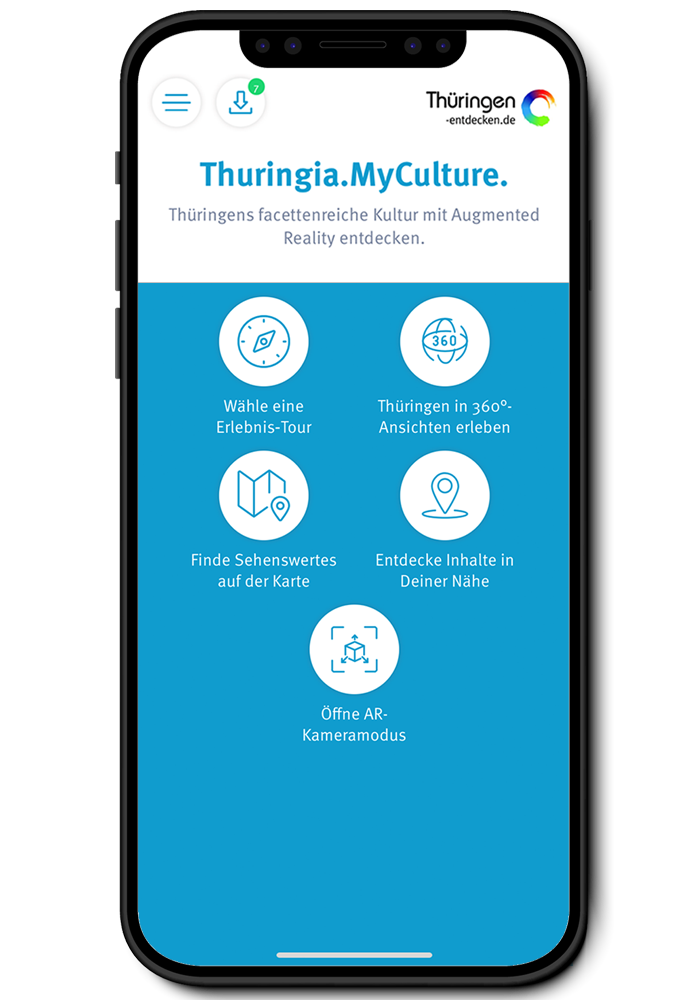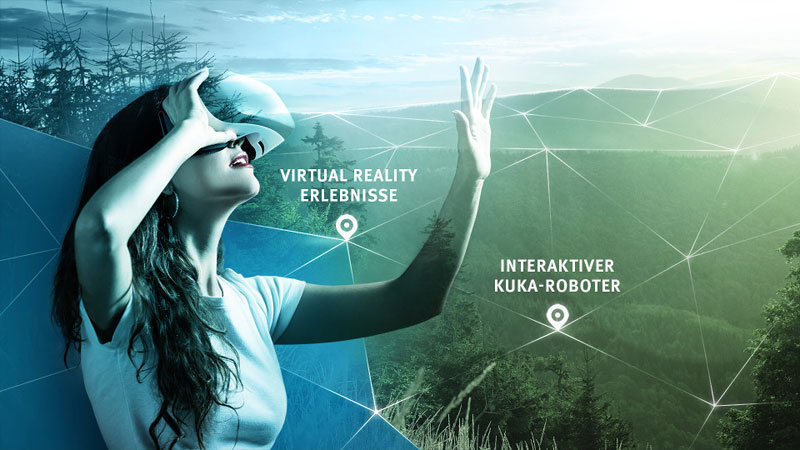Visit the state capital Erfurt and go on a virtual discovery tour through Thuringia.
Hiker's coronation
Goethe Trail Ilmenau
No question: every (school) child knows "Wandrers Nachtlied". But who knows where Goethe's world-famous poem was written? Answers can be found in the administration building of Ilmenau. Goethe once lived on its second floor when he was called to the porcelain and glass town on the edge of the Thuringian Forest to reform the tax system. Today, it houses the GoetheStadtMuseum, to which a bronze statue of Goethe on the bench in front of it points the way. Inside, display boards, rocks and a "treasure chamber", as well as films, tactile showcases and a tunnel that can be crawled (by children) take visitors on a journey through the town's history - and the personal history of Germany's greatest poet. Drawings, furniture and a historical photograph of the poem above bear witness to his 26 visits to Ilmenau.
It was written in a refuge on the 861-metre-high Kickelhahn, where Goethe stayed on 6 September 1780. The wooden wall served as a substitute for paper. And the lines are still there, less than five kilometers from Ilmenau. Or rather: again. After all, the hut burned down in 1870. However, it was rebuilt in its original form, with the verses now emblazoned on the wall on illuminated panels in 16 languages.
The freely accessible "Goethehäuschen" is one of the highlights of the Goethe Trail. It owes its name to several places of activity, encounters and remembrance that played a role in the life of the poet. Take Corona Schröter, for example. The first actress to play "Iphigenia", Goethe's early bestseller, is already mentioned in the administration building. You can visit her grave - and the Goethe fountain - at the cemetery around the corner. The hiking trail then leads under beech and lime trees to the Schwalbenstein, one of Goethe's favorite places. He apparently found the spot on the porphyry rock so inspiring that he wrote the fourth act of "Iphigenia in Tauris" there in just one day, on March 19, 1779. A place of power? At the very least, many people experience a sublime feeling when they look out over the sea of forest from the shelter that now stands here and reflect. Peace is above all treetops!
Fossil painting in the Ilm valley
To be awarded the "Wanderbares Deutschland" quality trail seal, a first in Thuringia in 2005, you need more than just a few culturally relevant places. First and foremost, seamless signposting. Check! Accompanied by occasional overview boards, the curved G, which Goethe often used as an abbreviation of his name in correspondence, guides hikers through mixed forests and across mountain meadows, past herbs, wild garlic and blueberries. The route, a combination of attractive scenery and historical interest, is another plus. Other stops are not always, but often, related to Goethe, and not always to his poetry. Take Manebach, for example, where he made scientific drawings in the garden of the Kantorhaus. The small village on the Ilm is considered the cradle of palaeobotany.
If you look back as you climb up to the Helenenruhe, you might think of Goethe's words: "Graceful valley, you evergreen grove, my heart welcomes you again in the best way ..." And whether this gem was perhaps also a model for model railroad landscapes. Because of the picturesque houses, the meadows, the dense spruce trees. There is even a railroad line, although it only runs on certain dates. At weekends, for example, the Rennsteigshuttle runs from Erfurt to Stützerbach (and further), sometimes even a steam locomotive.
Best views from the rock and tower
But as Goethe said: "Only where you've been on foot have you really been!" So we continue uphill, past the Sophienquelle spring to the Großer Hermannstein. The last few meters are covered via a ladder, but the slight scramble is worth it: on the one hand, the rock formation has many lichen and moss species, and on the other, a great panorama. It even inspired Goethe to paint "Dampfende Täler bei Ilmenau". This was not the only time he reached for a pencil instead of a pen; he also painted the nearby cave. However, without Charlotte von Stein, whom he met here for a tête-à-tête, as a sign reminds us.
Even though 1,700 letters attest to an intense relationship, it was probably platonic. In general, Goethe's courtship was far more passive than that of his friend, the Weimar Duke Carl August von Sachsen-Weimar-Eisenach. The two of them spent a lot of time in Ilmenau and their "beloved Stützerbach", enjoying water baths and wine. The episode in the poem "Ilmenau" entitled "Nachtlager im Finsteren Loch", a dark valley basin with a waterfall, provides insights like the painting of the same name: here the ducal revelry, there the sensible Goethe.
A few kilometers ahead, on the Kickelhahn, it is far and bright. In Goethe's own words: "The view is great, but simple." Great? Of course. But simple? Hmm. Although there was no observation tower back then. It wasn't built until 1855 and was the first of its kind in Thuringia. Since the renovation in 2021, the climb is even more worthwhile. 107 steps may make you feel a little twitchy, but a magnificent view awaits at the top.
Museums or nature? And!
Directly below, you can spot the dishes of the "Berggaststätte Kickelhahn", which are also "big and simple". The menu is similar to that of the "Auerhahn" forest restaurant. The "Berg- und Spa-Hotel Gabelbach" in between, trail restaurant number three, is much more sophisticated. Regardless of where you stop for a bite to eat or a picnic: keep an eye on the opening times of the museums! Firstly, there is the Jagdhaus Gabelbach museum. The late baroque functional building, hastily built in 1783 to serve as a guest house for Carl August and his hunting party (the banqueting hall is really something), houses interactive media stations as well as animal and plant specimens and hunting equipment.
What can be seen between the museums? Lots of nature! The Ochsenwiese meadow delights with a sea of yellow arnica, the romantic Schortetal valley with ferns and moss-covered stones on the riverbank, and then there is the Knöpfelstaler pond and the Finstere Loch. If you enjoy this most scenic section, take the detour via the Seifiger Teich pond. Or head straight for the final spurt to Stützerbach. Goethe wrote the following about this idyllic climatic health resort, which is still one of Germany's top 20 climatic health resorts: "What do I know what I like here, in this narrow, small world, with a quiet magic band that holds me ..."
The Goethe Hiking Trail from Ilmenau to Stützerbach, opened in the 1970s and awarded the title "Quality Trail Hikeable Germany" in 2005, can be completed in one (long) day if you are in good physical condition. The 19 kilometers and 715 meters of altitude are estimated to take 7.5 hours of hiking time, albeit net. In view of the sights along the way, we recommend at least two daily stages. Even if the signposting promises that the route is not difficult, the Ilmenau Information Office in the administation building provides free maps.
Courtly comfort hunt
Cover picture: ©Dominik Ketz, Regionalverbund Thüringer Wald e.V.
Accessibility
Did you like this story?
You might also be interested in ...














